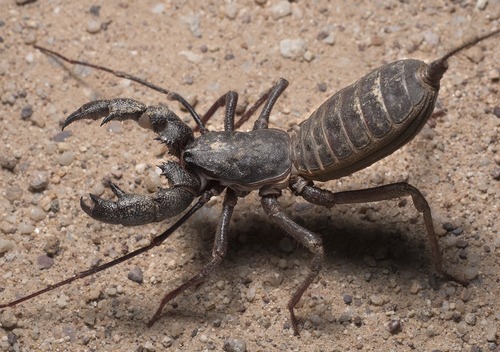Uropygi
 | |
| Kingdom: | Animalia |
|---|---|
| Subkingdom: | Bilateria |
| Infrakingdom: | Protostomia |
| Superphylum: | Ecdysozoa |
| Phylum: | Arthropoda |
| Subphylum: | Chelicerata |
| Class: | Arachnida |
| Order: | Uropygi |
The arachnid order Uropygi contains organisms more commonly known as whip scorpions or vinegaroons. Although they may be referred to as 'whip scorpions', they are not actually true scorpions (Order Scorpiones). The name 'vinegaroon' was coined off their unique ability to spray a mixture of acetic acid, caprylic acid, and water as a defense mechanism. Vinegar typically consists of 5–20% acetic acid; however, the chemical mixture secreted by vinegaroons typically contains up to 83% acetic acid, which can irritate and deter predators[3][4].
Characteristics and Morphology
As members of the class Arachnida, vinegaroons possess four pairs of legs. The first pair of legs are much thinner than the rest, as they are modified into sensitive, antenna-like structures. The remaining legs are used for walking. They have one pair of eyes on the front of their cephalothorax (front body segment) and up to five pairs on the sides. They are typically nocturnal and have poor eyesight, relying on their antenniform legs to sense their surroundings[5]. They bear a pair of large pedipalps, or appendages with pincer-like structures, used for capturing and holding onto prey, defending against predators, or digging up soil for burrowing. They use their chelicerae (mouthparts) to chew prey. Their opisthosoma (abdomen) consists of twelve body segments with a whip-like flagella (tail) on the end, explaining the name "whip scorpion". This tail has a similar use to their antenniform legs in sensing vibrations and olfactory chemicals in the air[6]. Vinegaroons have two pygidial glands at the base of their flagella where their vinegar-like secretions are produced. They can aim their tail towards predators when they feel threatened and release the acetic acid mixture with surprising accuracy[7]. Vinegaroons typically grow around 9 cm (~3.5 in) long when fully grown, but this size may vary between species[8].
Reproduction and Life Cycle
When mating, males will produce a packet of sperm, called a spermatophore, and transfer it to the female's genitals. Some species may exhibit a courtship "dance" when both the male and female are willing to mate. Males will hold the female's first pair of legs in their chelicerae and deposit the spermatophore on the ground, where it is picked up by the female. Males of other species may directly transfer the spermatophore to the female using their pedipalps[5].

Gravid females will then burrow into the soil and incubate their young. The female will lay a brood sac which will remain attached to her opisthosoma. After a couple months, the eggs in the brood sac will develop into nymphs and hatch. The amount of young per brood may vary across species, but typically lies between 20–40. The young resemble their adult forms, except they are white in color and have red or pink pedipalps. They will remain attached to the back of their mother using suckers until they undergo their first molt. Vinegaroons typically molt four times in four years until they reach adulthood[8]. They typically live 4–7 years in the wild, with females living longer than males[5].
Diet and Feeding Behaviors
Vinegaroons are voracious predators and mostly feed on invertebrates, such as worms, slugs, insects, scorpions, millipedes, and isopods. Larger species may also feed on small vertebrates like lizards[5]. Vinegaroons are often preyed upon by birds, lizards, and small mammals.
Distribution
Vinegaroons live in warmer climates including grasslands, scrubland, deserts, and tropical regions. They can also be found in pine forests and mountainous areas. They tend to hide under rotting wood, rocks, or burrowed in the soil and come out at night to hunt[6].
References
- ↑ Integrated Taxonomic Information System (ITIS). n.d. Uropygi. https://www.itis.gov/servlet/SingleRpt/SingleRpt?search_topic=TSN&search_value=82710#null
- ↑ Maltais, B. (2016). The Vinegaroon: A Salad with Frankenstein [Photograph]. https://www.macrophotobug.com/vinageroon-whip-scorpion-arizona/
- ↑ Helmenstine, A.M. (2019). Vinegar Chemical Formula. ThoughCo. https://www.thoughtco.com/vinegar-chemical-formula-and-facts-608481
- ↑ Smolinske, S.C., S.A. Seifert, B.W. Warrick, & Y. Tadfor. (2022). Vinegaroon exposures reported to a Poison center. Toxicon. https://www.sciencedirect.com/science/article/abs/pii/S0041010122002732
- ↑ 5.0 5.1 5.2 5.3 AnimalFact. (2024). Vinegaroon. https://animalfact.com/vinegaroon-uropygi/
- ↑ 6.0 6.1 Texas A&M AgriLife Extension. n.d. Vinegaroon. https://texasinsects.tamu.edu/vinegaroon/
- ↑ PBS Deep Look. (2022).The Vinegaroon Sprays Acid to Foil Its Foes [Video]. https://www.pbs.org/video/the-vinegaroon-sprays-acid-to-foil-its-foes-3csgr1/
- ↑ 8.0 8.1 Oakland Zoo. n.d. Giant Vinegaroon. https://www.oaklandzoo.org/animals/giant-vinegaroon
- ↑ cowyeow. (2012). Vinegaroon with Young [Photograph]. Uploaded to flickr. https://www.flickr.com/photos/cowyeow/10035768716